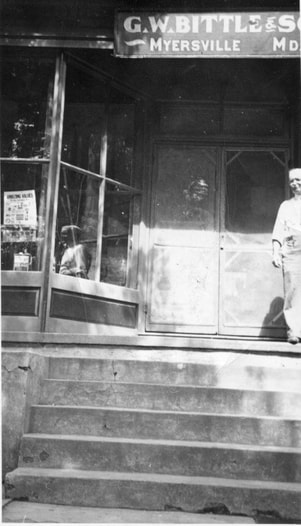
Amazingly—almost miraculously—on 8 August, just four days after the shooting, George Waters Bittle was able to give testimony to Justice of the Peace Christian H. Eckstein whilst propped up in a chair in the bedroom of his Main Street home. Also present during the testimony was State’s Attorney for Frederick County Arthur D. Willard (1872-1959), the counsels for the defense, the accused, Captain Jacob Koogle, Dr. Ralph Browning, Rev. Otto E. Bregenzer (abt. 1877-1920) of St. Paul’s Lutheran Church, and Mrs. Bittle, the former Mary Elizabeth Routzahn (1865-1936.)
Bittle told Willard and Eckstein that on the night of the attempted burglary, “He had seen the burglar around his place early in the evening [and] though he recognized his walk,” the Frederick News noted. “The party wore a dark slouch hat, dark coat, and trousers. He did not see the face of the man at the door sufficiently well to say it was George Koogle, but he could say from what he had seen of Koogle earlier in the evening and what he could say of the man at the door he thought it was George Koogle, although he was sorry to say so.” The dolorous look Bittle may have given Captain Koogle as he spoke can well be imagined.
Bittle, like his fellow citizens, likely saw Koogle as somewhat of a superhero. For example, the merchant would surely have heard this wartime anecdote from Myersville veteran Daniel Mowen, Koogle’s brother-in-law, who included it in a series of articles he wrote for the newspaper, The Globe: “At the assault of Petersburg, on the 17th of June, 1864, and while the Seventh [Maryland Regiment] was in line, Jacob Koogle, first sergeant of company, saw a shell bounding toward them. He called to the men to ‘look out!’ Watching its course, he attempted to step out of its way when it lodged against his breast. Its force being about spent, he threw it off with his arm without injury to himself and, as it didn’t explode, it injured no one else.” This was before the affair of stealing of the Confederate colors and returning with the secessionist banner and a uniform full of bullet holes. Those twin events could make anyone wonder whether Koogle was divinely blessed.
Continue reading at historian Ann Longmore-Etheridge's blog, Your Dying Charlotte.
Bittle told Willard and Eckstein that on the night of the attempted burglary, “He had seen the burglar around his place early in the evening [and] though he recognized his walk,” the Frederick News noted. “The party wore a dark slouch hat, dark coat, and trousers. He did not see the face of the man at the door sufficiently well to say it was George Koogle, but he could say from what he had seen of Koogle earlier in the evening and what he could say of the man at the door he thought it was George Koogle, although he was sorry to say so.” The dolorous look Bittle may have given Captain Koogle as he spoke can well be imagined.
Bittle, like his fellow citizens, likely saw Koogle as somewhat of a superhero. For example, the merchant would surely have heard this wartime anecdote from Myersville veteran Daniel Mowen, Koogle’s brother-in-law, who included it in a series of articles he wrote for the newspaper, The Globe: “At the assault of Petersburg, on the 17th of June, 1864, and while the Seventh [Maryland Regiment] was in line, Jacob Koogle, first sergeant of company, saw a shell bounding toward them. He called to the men to ‘look out!’ Watching its course, he attempted to step out of its way when it lodged against his breast. Its force being about spent, he threw it off with his arm without injury to himself and, as it didn’t explode, it injured no one else.” This was before the affair of stealing of the Confederate colors and returning with the secessionist banner and a uniform full of bullet holes. Those twin events could make anyone wonder whether Koogle was divinely blessed.
Continue reading at historian Ann Longmore-Etheridge's blog, Your Dying Charlotte.
 RSS Feed
RSS Feed